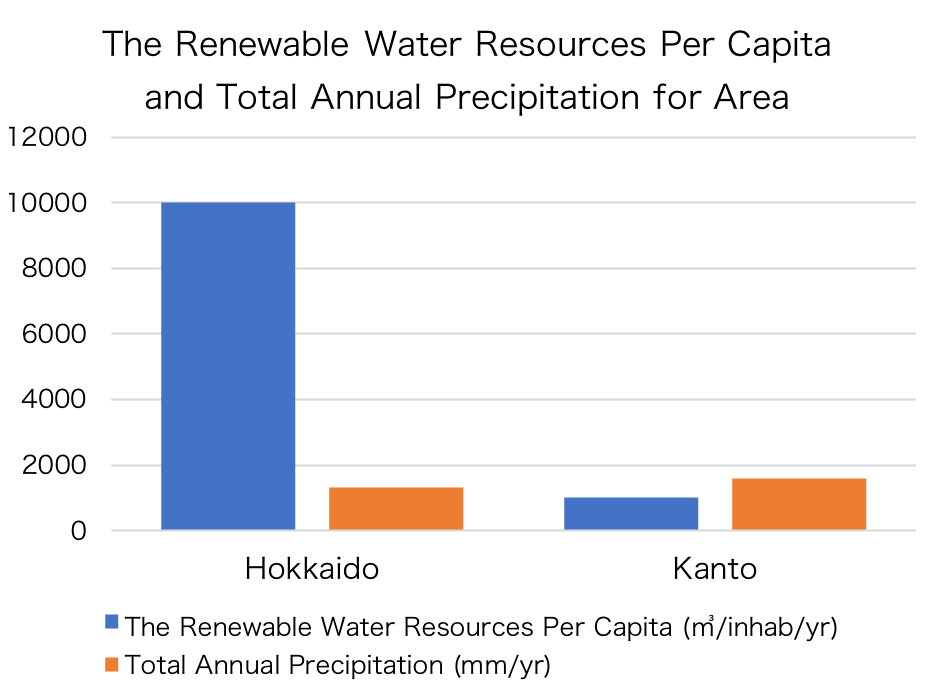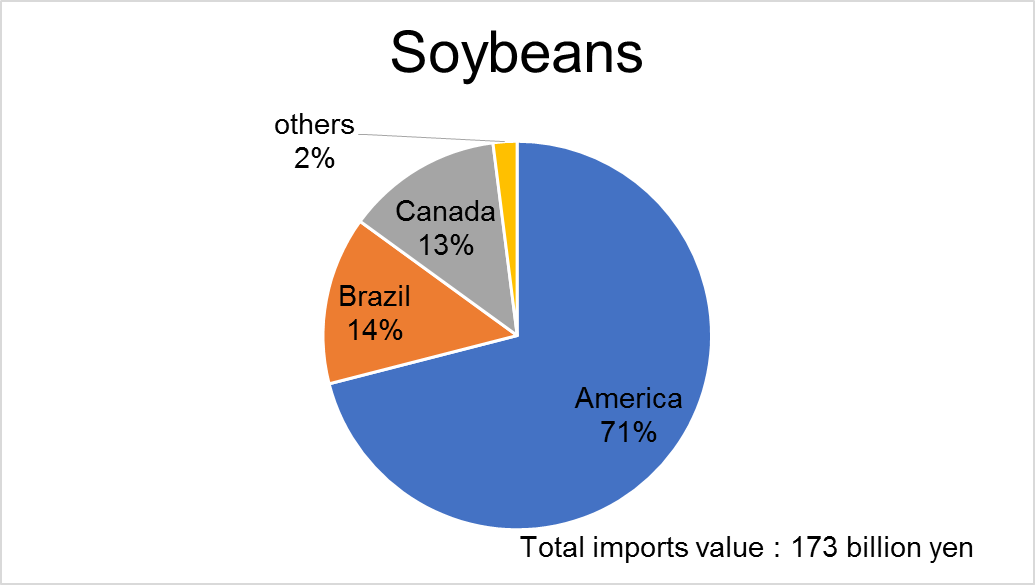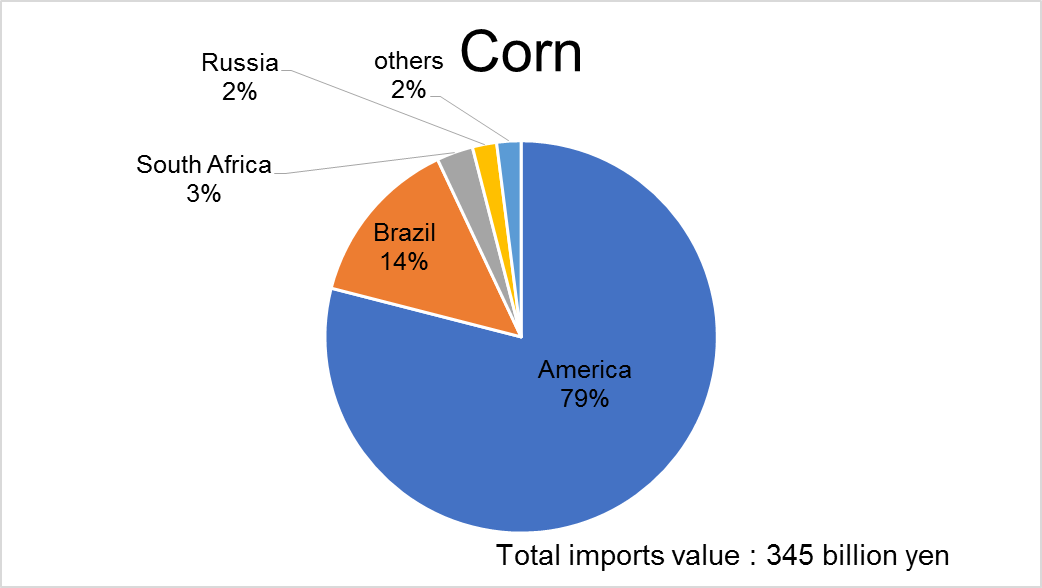Investigation for Resolution
Is Japan a Water Imports Country?!
First, let’s look at the current situation of water in Japan before looking at the world.
Climate of Japan
Japan is in Monsoon Asia and belongs to the heavy rain area. The average annual precipitation of Japan is 1,6688mm (*1) and that of Tokyo is 1528.8 mm (Map 1). This figure is twice as much as world average annual precipitation, 810 mm (*2). However, renewable water resources per capita of Japan is 3,397 ㎥/inhab/yr (*2). It is about one out of three world average.
We compared the annual precipitation of Japan and New Zealand. The results indicates that the they are almost the same.
Meanwhile, we compared the renewable water resources per capita of the two countries that of Japan is 3,000 ㎥/inhab/yr and that of New Zealand is about 70,000 ㎥/inhab/yr (*2).

The original graph made on the basis of the date (*2) from FAO

The original graph made on the basis of the data (*1) from Japan Meteorological Agency
Japan, with a high precipitation, has small renewable water resources per capita. Why?
Reasons
In spite of a high precipitation, Japan has small renewable water resources per capita. There are three reasons for it.
1. High population density
2. Steep slope lands
3. Decline in the water conservation power
Here are the detailed explanation.
1. High population density
The population density of Japan is 335 inhab/㎢ (*3). The proportion is higher than world average and Japan has great demand for water. In Japan, there are great differences in the renewable water resources per capita by areas. The following graph shows that there is a large difference in the renewable water resources per capita, although there is no great difference in the average annual precipitation in each area.
We compared Kanto with Hokkaido. Kanto is known as high population density while Hokkaido is known as low population density. The results show that the difference of renewable water resources per capita is nearly ten times.
The renewable water resources not only related to water resources brought by precipitation, but also to
the population as well as the area of the country.

The original graph made on the basis of the data (*3) from Japan Ministry of Land, Infrastructure, Transport and Tourism.
2. Steep slope lands
Rivers in Japan are short and steep, so one out of three precipitation flow into the sea.
Moreover, precipitation is concentrated in the rainy and the typhoon season. Although Japan has a lot of rain, actually
those water flow into the sea without being used.
3. Decline in the water conservation power
After World War II, Japan faced lack of houses. To get lumber, Japanese companies transplanted coniferous forest such as Japanese cedar and Japanese cypress. Because those plants are suitable for lumber.
The merit of coniferous forest is growing fast. However, there are also demerits. If people do not thin out forest correctly, the sun will not shine in the forest, then the trees will not grow.
Furthermore, these days, Japan imports a lot of cheap wood from foreign countries. Therefor, Japanese people began to leave forests because there was little demand for domestic wood, as it is quite expensive.
As a result, forests lose the water conservation power.
The renewable water resources per capita of Japan is about one out of three the world average. However, we do not feel water shortage. What is the reason for that?
In fact, there is a relation with food imports. Here comes a key word,
virtual water.
If you do not know virtual water, please click here.What Is Virtual Water?
Why Is the Quantity of Virtual Water of Japan so Large?
The quantity of virtual water imports of Japan is 64 billion ㎥/yr (*4). Japan is one of the countries that imports a lot of virtual water.
Why is the quantity of virtual water of Japan so large?
The Low Food Self-Sufficiency Rate
The figure shows the quantity of virtual water imports of Japan for each item. Agricultural and livestock products account for more than 90%. The food self-sufficiency rate based on calorific value of Japan is 38% (*5), especially soybeans, wheat and corn used feed are low rate. Japan depends on imports for those productions.
Also the meat self-sufficiency rate is 52% (*5) and meat imports value is 9.1 million dollars. Japan imports a lot of meat that required much water to produce.

This original graph made on the basis of the data (*7)
Why Did Japan Began to Import a lot of Water?
"Diversification of food" might be the answer for this question. Japanese people used to consume vegetable-based meals. Thus, in the past Japan could provide enough food although it does not import much food.
However, diet has become diversified and Japanese people began to eat meat. In addition, the population of Japan increased. Thus, domestic production alone cannot respond to the demand.
Professor Oki of University of Tokyo suggested that, “mizu kiki hontou no hanashi [water scarcity true story]”, says that
“Japan imports virtual water not because lack of water but because lack of flat land. It is difficult for Japan to get enough flat land for farming. To sum up, Japan imports animal feed and meat, so to speak, virtual farmland and also imports virtual water.”
The Influence of Japanese Food Import on Environment
The figures below show imports of Japan’s main agricultural and livestock products, and the partner countries. The figures indicate that Japan imports many agricultural and livestock products such as wheat, cone, soybeans and meat from the United States of America.
At present, in the United States, there is a problem that is groundwater depletion. Because JApan imports a lot of food from United States of America. It can be inferred that Japan is related to this problem occurring there as well.
*1:FAO. (2014). Long-term average annual precipitation in depth, Retrieved November 12, 2018
*2:FAO. (2014). Total internal renewable water resources per capita, Retrieved November 9, 2018
*3:UN. (2017). Demographic Yearbook 2017, Retrieved January 8, 2019
*4:Japan Meteorological Agency, Virtual Water, Retrieved November 9, 2018
*5:The Ministry of Land, Infrastructure, Transport and Tourism. (2018). The food self-sufficiency ratio, Retrieved November 9, 2018
*6:ITC. (2017). List of imported products for the selected product - Meat and edible offal, Retrieved November 9, 2018
*7 : Oki, T. (2012). Mizu kiki honto no hanashi [water scarcity true story].Tokyo : Shintyo sensho
*8 : Nihon kokuzei zukai 2018/2019 dai 76 ban [Japan national data 2018/2019]




Theses original graphs made on the basis of the data (*8)